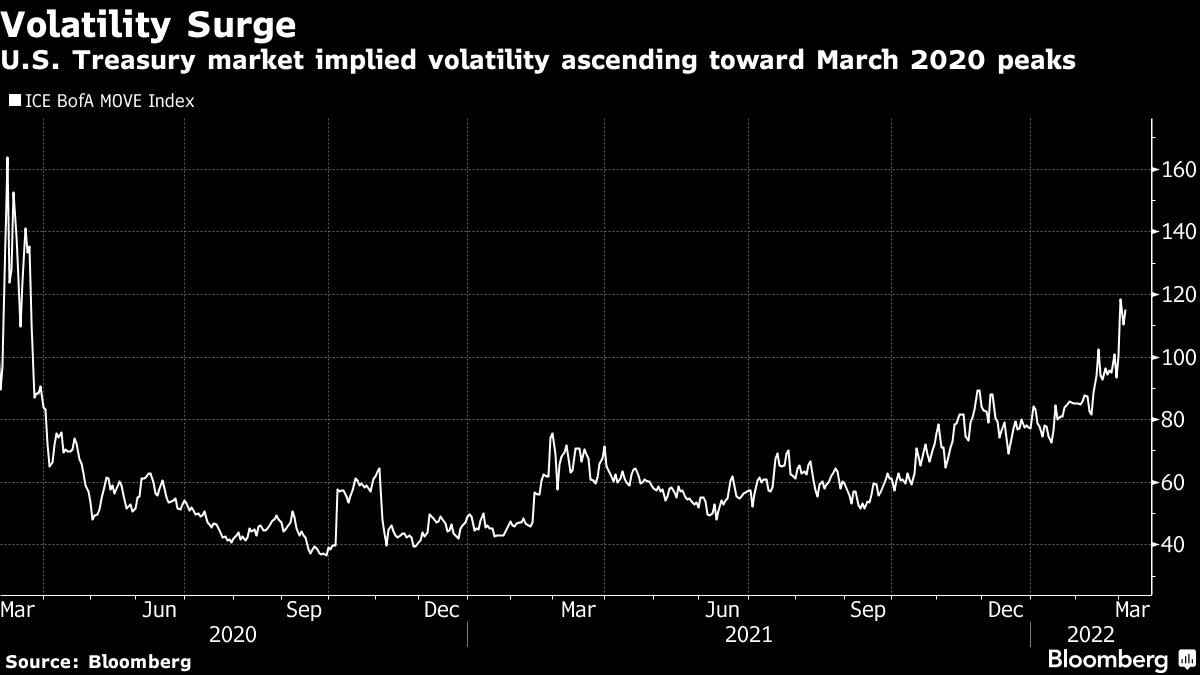Bond Traders Primed for Wild Swings With Inflation, War in Focus

(Bloomberg) — After a tumultuous week of big yield swings and heightened volatility in the U.S. Treasury market, investors are bracing for another hot inflation report, while the war in Ukraine increasingly casts a pall over Europe and the global economy.
Most Read from Bloomberg
Russia’s Feb. 24 invasion of Ukraine began to rewrite the script for U.S. bond yields, some of which earlier in the month had climbed to the highest levels in more than a year in anticipation of Federal Reserve interest-rate hikes to curb inflation beginning this month.
The international campaign to cut Russia off from its resources stoked oil and agricultural commodity price increases that worsen the inflation outlook, but it also poses risks to the global financial system — where stresses began to appear — and growth that make investors want to buy Treasuries. The two-year note’s yield, which peaked last month at 1.64%, this week ranged from 1.26% to 1.56% and ended lower by more than nine basis points. The 10-year yield, less sensitive to changes in the Fed’s policy rate, dropped by 23 basis points, the most in a week since the onset of the pandemic in March 2020.
The war in Ukraine “dominates the news cycle and no one knows how long it lasts,” said Molly Schwartz, portfolio manager at Western Asset Management Co. “There is also the Fed and its inflation problem,” which rising commodity prices threaten to prolong. “Their job is one of being reliable, predictable and not scaring the market.”
The market is already expecting further upheaval in yields. A measure of implied Treasury volatility stands at levels last seen during the tumult of March 2020.
The crisis also unleashed a fresh wave of demand for Treasury inflation-protected securities, whose performance had stalled amid the signs that Fed policy makers were prepared to crack down on the trend in consumer prices. The yield on 5-year TIPS fell to a 2022 low on March 1, and the average expected inflation rate it implies closed above 3.3% for the first time.
For now, the war in Ukraine and the exclusion of Russia’s economy from Western capital and markets via sanctions has spurred huge demand for the dollar and Treasuries despite the inflation threat and strong U.S. job-creation data for February released Friday. The prospect of U.S. currency scarcity in money markets fueled a gain of 1.3% in the past week, while the euro plunged more than 3% ahead of next week’s European Central Bank policy meeting.
Meanwhile, U.S. central bankers are in a communications blackout until their mid-month policy meeting. The latest word, from Jerome Powell, awaiting confirmation to a second term as Fed chair, was that a quarter-point rate increase is effectively a done deal, and that half-point increases are possible in the future if inflation doesn’t moderate. Interest-rate futures continue to price in at least five quarter-point hikes this year.
The U.S. consumer price index to be released next week is forecast to show a 7.9% year-on-year increase in February, up from 7.5% in January, the highest rates in four decades. Excluding food and energy prices, the expected rate is 6.4%, up from a prior reading of 6%, according to economists surveyed by Bloomberg.
“The Fed needs to re-establish its inflation-fighting capability,” said Jason Pride, chief investment officer of private wealth at Glenmede Investment Management. The question is whether it can do so without tipping the economy into recession. “The Fed will follow market expectations of rate hikes with the aim of not destabilizing the economy and financial markets,” he said.
Increasingly, the bond market expects a stagflationary outcome for the economy — long-dated yields are declining faster than short-dated ones. The difference between two- and 10-year yields breached 23 basis points Friday. It was above 90 basis points as recently as January. The curve was last inverted in August 2019.
There’s scope for the flattening trend to abate next week. Long-dated Treasuries may cheapen ahead of $34 billion 10-year note and $20 billion 30-year bond auctions Wednesday and Thursday, and the Fed is slated to conduct its last two purchases of Treasury securities, its other main policy lever.
“If the Fed tightens by 100 basis points before July, it will invert the curve,” an outcome it may seek to avoid, said Kevin Flanagan, head of fixed income strategy at Wisdom Tree Investments. “It will be interesting to see how the Fed plays this.”
The upshot for the bond market is that 2022 has already delivered plenty of volatility and little hope that it will abate soon. Any receding of the war in Ukraine will switch the focus back to the trajectory of rate hikes and the implications for inflation and the economy.
“At present the likelihood is for slower growth and not a recession,” despite headwinds from higher oil prices, Pride said. Unfortunately, “no one can predict political outcomes.”
What to Watch
-
Economic calendar:
-
March 8: NFIB Small Business Optimism, trade balance, wholesale inventories
-
March 9: MBA mortgage applications, JOLTS Job Openings
-
March 10: Consumer Price Index, jobless claims, monthly budget statement
-
March 11: University of Michigan Sentiment survey
-
-
Fed calendar:
-
Federal Reserve in quiet period ahead of March 16 policy meeting
-
March 8-9: Final two scheduled Treasury purchase operations
-
March 10: European Central Bank meeting
-
-
Auction calendar:
-
March 7: 13- and 26-week bills
-
March 8: 3-year notes
-
March 9: 10-year notes
-
March 10: 4- and 8-week bills, 30-year bonds
-
Most Read from Bloomberg Businessweek
©2022 Bloomberg L.P.




